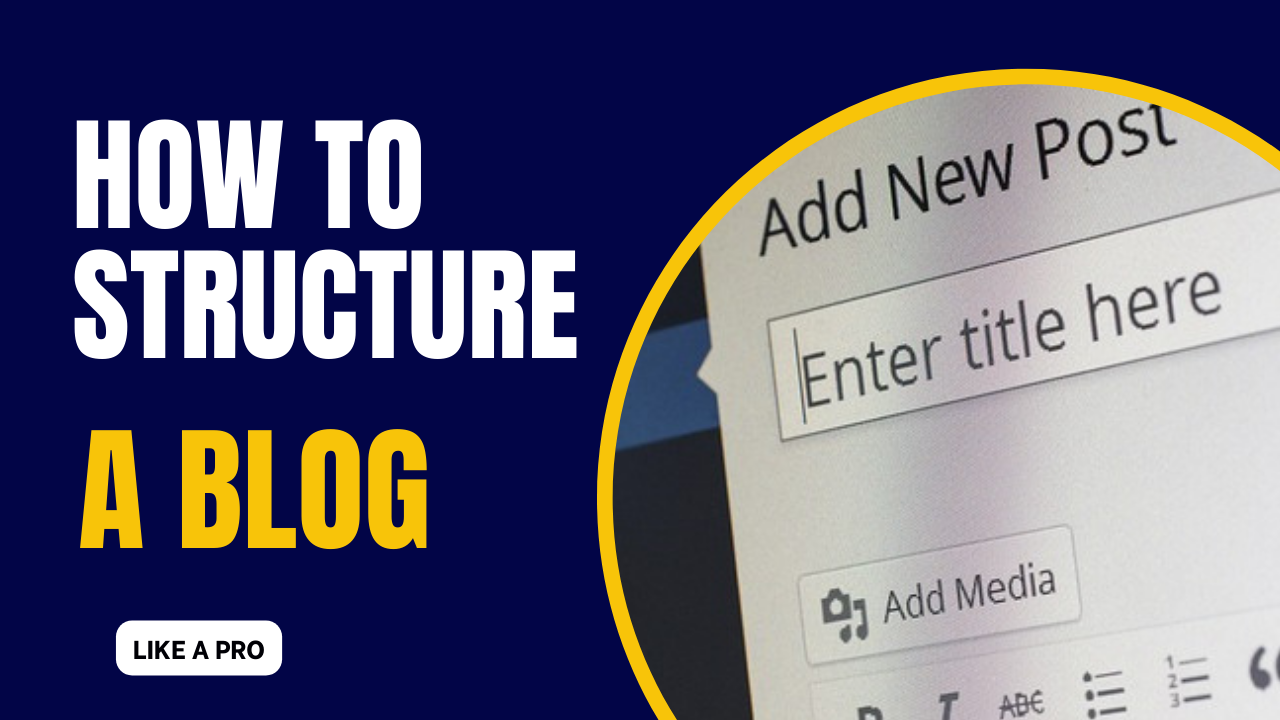
Do you spend hours working on the content of your blog without obtaining satisfactory results? This is not inevitable! Know that for a text to please your readers and rank well on Google, it must be constructed thoughtfully! But then, how to properly structure a blog article? I share my tips with you and explain the 11 steps to follow to organize your next post like a pro!
Quick reading: how to structure a blog post in 11 steps
Here is a summary of the 11 steps to properly structure a blog post! This will not replace training in web writing, but you will at least have all the ideas to structure a text that meets the needs of Internet users and search engines.
- Choose the right themes
- Find the keywords
- Know your readership
- Look for reliable sources of inspiration
- Make a writing plan
- Write the blog post
- Optimize content
- Add media
- Offer internal and external links
- Fill in the metadata
- Reread its content
As you read the rest of this post, you will find more details on each of these 11 steps. You can then start writing your blog article without further delay!
Why do you need to structure a blog post?
We can easily divide bloggers into two categories! Some simply want to express their point of view or share their experiences. Others want to attract organic traffic and captivate their reader. If you fall into this second category, then you certainly want to know how to properly structure a blog article!
Indeed, the structure of your blog post is essential to achieving your objectives. it allows to :
- respond quickly to the query intent;
- reduce the bounce rate;
- keep your visitor’s interest;
- improve your conversion rate;
- match Google’s ranking criteria;
- increase your visibility on search engines;
- increase your SEO traffic.
But then, how do you write an article on a blog that achieves all its results? Despite preconceived ideas, it is not enough to rush headlong into writing your content! There is preliminary work to be done and a precise way to proceed. Below, I invite you to discover the 11 steps I use to properly structure a blog article.
11 steps to properly structure a blog post
Here, I share with you how I go about writing an SEO blog post. Before I even start writing, I take the time to do a preliminary analysis. Then, I write following a precise methodology. Finally, I take care of natural referencing optimization. Here are the 11 steps I follow to structure a blog post!
1- Choose the right themes
To choose the right themes, you consider two factors: your area of expertise and your target reader. Indeed, your goal is to prove to Google that you are an essential specialist in your sector and that your expertise is complete on a very specific topic. Additionally, you want to meet the needs and expectations of your readership.
To do this, I first start by thinking about all the topics that correspond to the website I work for. If you are lacking inspiration, don’t hesitate to take inspiration from your SEO competition! Then I search Google for related research suggestions and other questions asked. Finally, I use some SEO tools to establish an effective thematic cluster strategy.
After having done this analysis work, you can group all this information into an editorial plan. This way, you can organize your future actions and structure the work of your editorial teams. Please note that it is also possible to use our SEO tool to establish this document.
2- Find the keywords
Now that you know the topics you are going to cover in your next blog posts, you need to do some keyword research. To achieve this, you can use tools like Ubersuggest, SEMRush or Ranxplorer. In addition, it is interesting once again to take inspiration from the Google SERP to find ideas.
My advice is to not only focus on high search volume keywords. Indeed, they are often extremely competitive. It will therefore be difficult for you to position your blog article on these complicated queries, especially if your website does not have a high reputation. Don’t hesitate to work on long tails and local queries to be visible on the first page of Google.
When writing your blog post, try to focus on just one keyword per text. Be aware, however, that if your content is comprehensive and well optimized, it will certainly appear on a whole group of related queries. So, even if you haven’t targeted a word with a thousand monthly searches, you will still be able to attract significant traffic thanks to dozens of words searched only ten times per month.
3- Know your readership
Remember that you are writing for human beings, not for web crawlers. It is therefore essential to clearly define your target reader to adapt your writing to their profile. Before writing your first blog article, I advise you to do an in-depth analysis of your SEO persona.
Of course, your editorial style must also match your brand image. This is why it is strongly recommended to establish an editorial line. You can then share it with your entire editorial team in order to harmonize the way you communicate on your blog.
By doing this, you put all the chances on your side to interest your reader, retain your traffic and improve your conversion rate. Once these first three steps have been completed, you can finally start writing your blog article!
4- Look for reliable sources of inspiration
You have your keyword in mind and are ready to write your content. You may know your subject perfectly and don’t need inspiration. However, it is always interesting to know what Google considers relevant.
I therefore suggest that you take an overview of search engines to fully understand search intent and see how your competitors have structured their content. This will also help you carry out the next step, namely establishing a writing plan.
Additionally, to have a chance of ranking your blog post in the top position, you need to do better than your competitors. Therefore, take the time to find reliable sources before writing your first line. To find out if they are reliable, you can:
- check the reputation of the site (with Majestic SEO or Ahref);
- check the presence of legal notices and T&Cs (often in the footer);
- make sure that the writer is recognized in the field covered (a quick search on LinkedIn is a good way to do this);
- quickly browse the entire blog to see if the themes are relevant to your subject;
- see if the site appears on related searches.
5- Make a writing plan
Making an editorial plan before writing is essential. Please note that this plan is not rigid and that it will surely be necessary to review it during your writing. However, it allows you to structure the information and ensure that you are covering the entire subject.
5.1 TITLE (H1)
Choose a title that describes in a few words the topic covered in your blog post. It must offer a solution for the Internet user and your content must correspond to this promise. Personally, in order to ensure the relevance of the title, I finalize it only after having finished writing my text.
5.2 INTRODUCTION
It’s the hook of your blog that will make your visitor want to continue reading. For it to be optimal, I advise you to present a problem with which the reader can identify and to provide them with the solutions proposed in the rest of the article. Once again, I only refine this element once my article is complete.
5.3 SUBTITLES (H2, H3, ETC.)
Subtitles are essential to ensure the completeness of your content. In addition, they are essential to facilitate diagonal reading, which is a common habit on the Internet. Dividing your text into subcategories helps you ensure that you cover the entire topic and significantly speeds up writing.
5.4 CONCLUSION
This is the last impression you leave on your reader. It is therefore important to take care of it! The conclusion should generally summarize the content covered in your blog article before proposing an expansion of the subject, a move to action (CTA) or an optimal solution to meet the Internet user’s needs.
6- Write the blog post
All the elements are now in place to be able to write a blog article in the best conditions. I then like to let my fingers go on the keyboard and write my content without worrying about optimization. I write as ideas come to me, drawing inspiration here and there from previously chosen sources.
Please note, however, that to properly structure a blog article, it is very important to quickly respond to the promise made in your title. To do this, we use a technique called the inverted pyramid. The main content must therefore be divided into paragraphs that follow this structure.
7- Optimize content
Once your blog post is finished, I advise you to do an optimization score check. First of all, make sure your content is readable. To optimize it, you can shorten your sentences (maximum 20 words) and air out your text.
Secondly, it is appropriate to check whether the lexical field is well-developed and whether the semantics are good. To carry out this task, I invite you to use our semantic analysis tool.
Finally, check that your key query is present in the H1 title, in the introduction and in the body of the text. Also place it in some of your subtitles and add a few synonyms or equivalents to vary the information and not overoptimize your blog post.
8- Add media
The media allow you to illustrate your words, provide rest for reading and add information to your content. So feel free to add some of the following to your blog post:
- Pictures ;
- infographics;
- videos;
- podcasts.
For the SEO optimization of your images, think about the format (JPEG, PNG or WebP), their size (maximum 1,280 px), their weight (maximum 100 KB) and their alt attribute (place a keyword there). !)
9- Offer internal and external links
Internal linking is an absolutely essential factor for improving your natural referencing. When you structure a blog article, consider offering relevant internal links to complement the information you offer. This will please your reader and Google, so don’t deprive yourself of it!
On the same principle, external links are also interesting for your SEO. To add value to your content, don’t hesitate to mention reliable sources and quality content. Little tip: to avoid losing your traffic, remember to force these links to open in a new tab!
10- Fill in the metadata
Metadata is the information displayed on search engine results pages. You must therefore take care of them in order to make the Internet user want to discover your content and thus improve your click-through rate.
10.1 Metatitle
The metatitle (Title tag) is an element of great importance in SEO. Do not hesitate to offer a different version of your H1 title to further improve your SEO.
Further read : how to properly write a metatitle
10.2 Metadescription
Even if the meta description does not have a direct influence on SEO, it remains an important factor that you should not neglect. This summary course allows the Googler to quickly understand the interest of the result displayed.
Further read : how to write the best metadescription
11- Reread your content
Proofread before publishing your blog post! To be quick and efficient, I proceed as follows: I first proofread aloud, then I use an automatic reading tool. This way, I easily find typos while ensuring the layout of my post.
Conclusion
By following these 11 steps, you are sure not to forget even the slightest element when creating your next blog post. Remember that this is done in four distinct phases: research, writing, optimization and control. Thanks to this methodology, you will be able to write faster and improve the positioning of your articles on search engines.
Before you started reading, you were wondering how to properly structure a blog post. Do you think you have all the information to get started now? Have you learned any new techniques? Or do you know other tips for writing a successful article?





